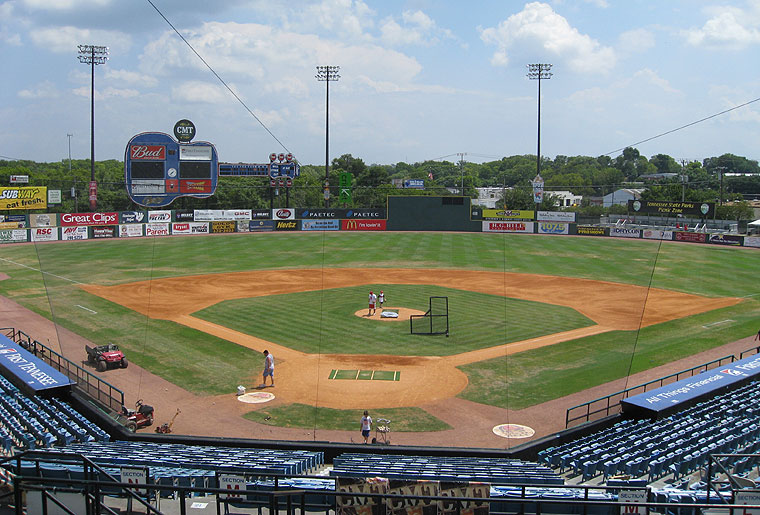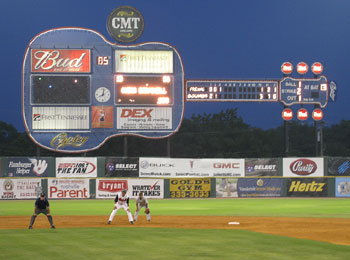
|
Greer Stadium looks and feels old. It’s a weathered relic of what ballparks looked like in the 1970s, the era during which it was built. The design is simple, amenities are few and the location poor. Only a scoreboard shaped like a guitar makes the place memorable.
If Greer Stadium were built today it would fail to meet Triple-A standards, and a friend of mine who is an announcer in the Pacific Coast League rates the ballpark as the worst in the 16-team league. For starters, there’s nothing pleasing about the ballpark’s white brick exterior. The inside doesn’t fare any better, as Greer Stadium’s single tier grandstand is constructed of weathered concrete, rusted aluminum and rotting wood. The non-symmetrical seating bowl extends from the right field foul pole to shortly past third base. Seats are colored faded shades of blue and aluminum bleachers make up a portion of general admission. The single level grandstand holds the majority of the ballpark’s 10,139 capacity, which is just 139 seats above the Triple-A minimum. Tables on wooden picnic decks down the left field line and behind the right center wall are popular places to eat, drink and watch the game. The main concourse is not open to the playing field, but it does provide one of the ballpark’s nice touches as each of the six concession stands are named after former Nashville Sounds greats who advanced to the Major Leagues: Magglio’s Pizza (Magglio Ordonez), Dibble’s Den (Rob Dibble), Donnie’s Delights (Don Mattingly), Skeeter’s Scoops (Skeeter Barnes), Fielders Choice (Prince Fielder) and Buck’s Backyard Grill (Buck Showalter). Each player is shown on a baseball card from their Nashville playing days. From the concourse, there is a single, non air-conditioned elevator that provides access to the team offices (2nd floor), the suites and press box (3rd floor), and a bar and restaurant (4th floor). To call the 18 suites luxurious would be a stretch; sky boxes are more appropriate. Sluggers Restaurant is the name of the full service top floor restaurant and bar. It has a capacity of 125 people and opens 90 minutes before the game. The suites, press box and restaurant are all behind large panels of glass, which adds to the stadium's dated look.
Measuring 116 feet wide by 53 feet tall and standing 80 feet above the ground behind the left center field wall, the guitar scoreboard is a dominating presence in the ballpark. Ads and basic game information fill up the 60’ guitar body, the line score is on the 36’ neck, and balls, strikes and outs are recorded on the 19.6’ tuning key section. Any player that hits the scoreboard with a home run is awarded a real guitar in a post-game ceremony at home plate. The feat isn’t all too uncommon, as I saw the diminutive Callix Crabbe accomplish it on my sole visit to Greer Stadium. Although the guitar scoreboard is the most unique at any level of baseball, it’s an old fashioned dot matrix scoreboard and is not capable of showing video replays. The lack of video replay capability is one of many reasons that Greer Stadium is an aging relic of the past. Its isolated location near an industrial section on the outskirts of Nashville is another. The ballpark is surrounded by trees and bordered by a railroad track and Fort Negley, a restored Civil War fortress that now serves as a military history park. Although Fort Negley was deemed worthy of restoration, Greer Stadium doesn’t merit renovation and has languished as a lame duck ballpark while the team and city work on a plan to replace it. All indications were that a new ballpark would be built downtown on the banks of the Cumberland River when the Nashville Metro Council approved plans for a $47 million, privately financed stadium on February 7, 2006. With a sponsor on board, the ballpark was to be named First Tennessee Field and slated to open in 2009, becoming the centerpiece of a mixed-use development. But that deal fell apart when the Sounds and their private developer were unable to finalize financing and ballpark design plans by an April 15, 2007 deadline set by the Council. Now the team is faced with an uncertain future in Nashville, as their plans for a new ballpark have been tabled and any further discussion of Greer’s replacement will depend on the willingness of local politicians to reconsider the project in the future. But time is of the essence, as the Sounds’ lease at Greer Stadium ends after the 2008 season and the prospects of the team staying at their run down, out of the way, three decades old ballpark are slim. Ironically, Greer Stadium was built to lure professional baseball back to Nashville in 1978 but now the Sounds very existence in the city depends on leaving the only stadium they've ever called home. If a new ballpark isn’t on the immediate horizon affiliated baseball will probably leave Nashville, and that’s not music to the ears of a town renowned for producing tales of heartbreak.
Location and ParkingNashville doesn’t seem to consider their current ballpark a point of civic pride, which would explain why there are no signs for it on the Interstate letting you know when to exit. That exit number is 81 (Wedgewood) off of I-65, from which the ballpark’s light towers are visible. The exit numbers on the Interstate are confusing, as I-24, I-40 and I-65 all merge near the vicinity of the ballpark, so the southbound exit numbers go from 84A to 209 to 210 to 81. Once exiting the Interstate, signage leads you to the ballpark a short distance away. Parking at Greer Stadium is free. A parking lot wraps around the stadium from foul pole to foul pole. Season ticket and VIP parking is behind the first base grandstand, while the much larger main parking lot runs parallel to the left field line. Half of the public lot is paved. The half furthest from the stadium is gravel. There’s also plenty of surface street parking near the ballpark.

Greer Stadium Footnotes - Facts & Figures
| |||||||||||||||||||||||||


 Nashville is better known as the country music capital than the capital of Tennessee, and Greer Stadium’s signature feature is the
Nashville is better known as the country music capital than the capital of Tennessee, and Greer Stadium’s signature feature is the 
